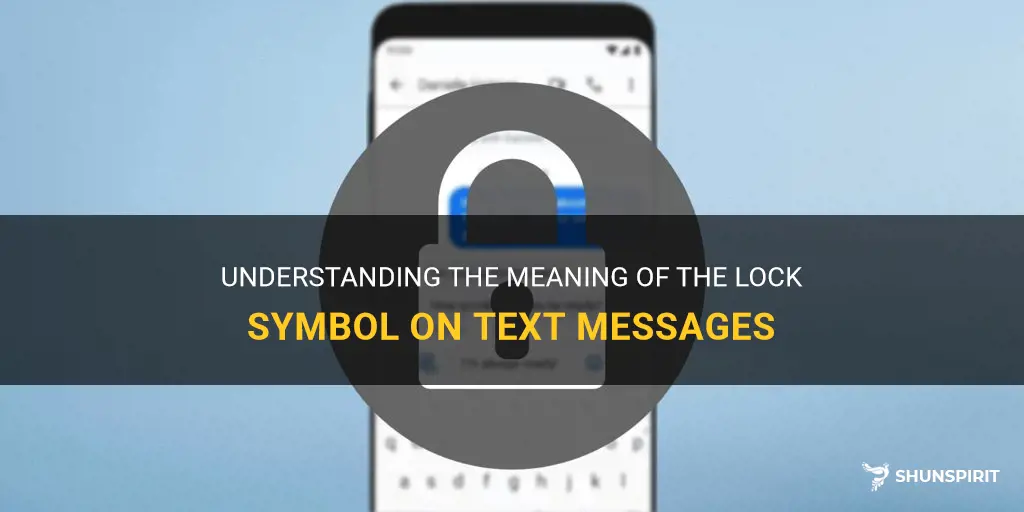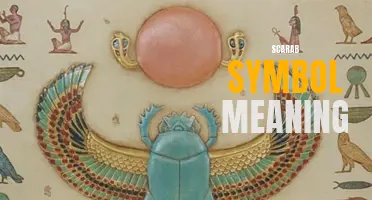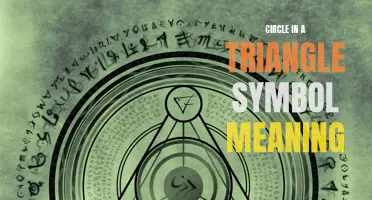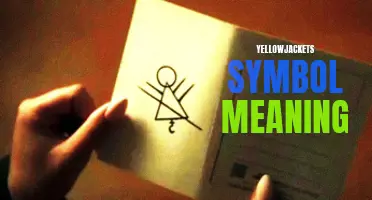
Have you ever noticed a little lock symbol on your text message? It may seem like a harmless graphic, but it actually holds a deeper meaning. This lock symbol signifies that your message has been securely encrypted, ensuring that only the intended recipient can access and read it. In a world where privacy is becoming increasingly important, understanding the significance of this lock symbol can bring you peace of mind knowing that your private conversations remain confidential. So, let's dive into the fascinating world of text message encryption and discover the power behind that tiny lock symbol.
What You'll Learn

What does the lock symbol on a text message mean?
The lock symbol on a text message typically indicates that the message is encrypted. Encryption ensures that only the intended recipient can read the contents of the message, providing a level of privacy and security.
When a message is encrypted, it means that the data within the message has been transformed using complex algorithms, making it difficult for unauthorized individuals to access or understand the information. Encryption is commonly used in various forms of communication, including text messages, to safeguard sensitive or confidential data.
The lock symbol itself serves as a visual representation to indicate that the message is protected. It is often displayed next to the message or within the messaging app. Some messaging apps may also display a padlock icon or other similar symbols to explicitly show that the message is encrypted.
The encryption process begins when the sender initially composes the message. The text is transformed into a string of characters through mathematical operations and cryptographic keys. These keys are like secret codes that are known only to the sender and the intended recipient. The encrypted message is then transmitted through the network to the recipient's device.
When the encrypted message reaches the recipient's device, it is decrypted using the recipient's unique cryptographic key. The message is transformed back into its original form and can be read by the recipient. The decryption process is usually seamless and happens in the background, so the recipient does not need to perform any additional steps to access the message.
The lock symbol is an essential indicator for users to know that their conversation is secure. It provides assurance that their messages cannot be easily intercepted or accessed by third parties. This is particularly important in today's digital age, where privacy and data security are constant concerns.
It is worth noting that the encryption and lock symbol only provide protection during the transmission and storage of the messages. Once a message is decrypted and read by the recipient, it can still be vulnerable to other security risks. For instance, if the recipient's device is compromised, the decrypted message could be accessed by an attacker.
To ensure maximum security, it is advisable to use messaging apps and platforms that offer end-to-end encryption. End-to-end encryption means that the message is encrypted on the sender's device and can only be decrypted by the intended recipient's device. This type of encryption provides the highest level of protection, as even the service provider cannot access the contents of the encrypted messages.
In conclusion, the lock symbol on a text message signifies that the message is encrypted and protected. This symbol serves as a visual cue to users that their conversations are secure and their privacy is maintained. Understanding the significance of the lock symbol can help users make informed decisions about their messaging habits and choose platforms that prioritize data security.
Exploring the Meaning Behind the Battery with Recycle Symbol
You may want to see also

Why does the lock symbol appear on some text messages but not others?
When sending a text message, you may have noticed that some of your messages have a small lock symbol next to them, while others do not. This lock symbol serves as an indication of the security level of your messages and can provide valuable information about the privacy and encryption of your conversations.
The lock symbol typically appears on text messages that are sent using end-to-end encryption. End-to-end encryption is a security measure that ensures only the intended recipients can read the message. This means that even if someone intercepts or gains access to the message during transit, they will not be able to decipher its contents.
When a lock symbol is present, it means that the messages are encrypted from the moment they leave your device until they reach the intended recipient's device. This provides an extra layer of security and privacy for your conversations, as it prevents unauthorized access or surveillance.
On the other hand, if a message does not have a lock symbol, it means that the message is not encrypted or has only partial encryption. This could be due to various reasons, such as using a different messaging platform that does not offer end-to-end encryption or sending a message to a recipient who does not have the necessary encryption settings enabled.
It is essential to understand the level of encryption and privacy offered by the messaging platforms you use. Some popular messaging apps, such as Signal and WhatsApp, are known for their strong encryption protocols and often display the lock symbol to indicate the presence of end-to-end encryption. However, not all messaging apps prioritize privacy and security to the same extent, and it is important to research and choose your messaging platform accordingly.
In addition to the lock symbol, some messaging apps may also provide other indicators of encryption, such as a color-coded background or a notification that the conversation is secure. These indicators can help you quickly identify whether your messages are encrypted or not.
In conclusion, the lock symbol appearing on some text messages but not others indicates the presence of end-to-end encryption. This encryption ensures that your messages remain private and secure, even if they are intercepted or accessed without your consent. It is crucial to choose messaging platforms that prioritize encryption and take the necessary steps to protect your conversations online.
The Symbolic Meanings Behind the Letter Y
You may want to see also

How can I remove the lock symbol from a secured text message?
Many smartphones and messaging apps now offer the option to send secured text messages, which are encrypted to protect the privacy and security of the user. While this is a great feature to ensure that your messages remain private, it can also be frustrating if you want to remove the lock symbol from a secured text message.
Fortunately, there are a few methods you can try to remove the lock symbol from a secured text message, depending on the messaging app or smartphone you are using. Here are a few possible solutions:
- Disable the encryption feature: Some messaging apps allow you to disable the encryption feature for specific conversations or for all your messages. Check the settings of your messaging app to see if there is an option to disable encryption. Keep in mind that disabling encryption may reduce the privacy and security of your messages.
- Revoke the encryption key: If you have sent the secured text message to someone else and want to remove the lock symbol, you can try revoking the encryption key. This will ensure that the recipient can no longer decrypt the message. However, this method will only work if the messaging app or platform you are using supports key revocation.
- Switch to an unsecured messaging app: If you are not concerned about the privacy and security of your messages, you can switch to a different messaging app that does not offer encryption. This will remove the lock symbol from all your messages. However, keep in mind that unsecured messaging apps may be more vulnerable to interception and unauthorized access.
- Contact the app or smartphone manufacturer: If none of the above methods work, you can try contacting the app or smartphone manufacturer for assistance. They may be able to provide specific instructions or offer further solutions to remove the lock symbol from a secured text message.
It's important to note that the options mentioned above may vary depending on the messaging app or smartphone you are using. Some apps and smartphones may not offer the ability to disable encryption or revoke encryption keys. In such cases, you may need to explore alternative messaging apps or contact the app or smartphone manufacturer for further assistance.
Remember that secured text messages are designed to protect your privacy and security, so remove the lock symbol only if you have considered the potential risks and implications.
The Definitive Guide to Icon Cash App Symbols and Their Meanings
You may want to see also

Do locked text messages have additional security measures?
In today's digital age, privacy and security of communication have become a top concern for individuals. Many people now opt for locking their text messages in order to protect their private conversations from prying eyes. But do locked text messages have additional security measures?
The answer to this question varies depending on the method used to lock the text messages. Here are a few common methods and the security measures they provide:
- App Locker: There are several apps available on both Android and iOS platforms that allow users to lock their text messages using a PIN, password, or fingerprint. These app lockers provide an additional layer of security by encrypting the locked messages, making it difficult for unauthorized users to access them. Some app lockers may also offer advanced features such as stealth mode, which hides the app icon from the home screen, further securing the locked text messages.
- Built-in System Lock: Some smartphones come with built-in options to lock text messages using a system-level lock feature. These locks are often integrated with the device's biometric authentication methods, such as fingerprint or face recognition. By using the built-in system lock, users can ensure that their locked text messages are only accessible to authorized users. This method also provides encryption of the locked messages, enhancing their security.
- Encrypted Messaging Apps: Instead of relying on the built-in text messaging app, users can also opt for encrypted messaging apps such as Signal or WhatsApp. These apps provide end-to-end encryption, ensuring that only the intended recipient can read the messages. When locking the app with a PIN or biometric authentication, the locked text messages in these apps receive an additional layer of security.
While these methods offer additional security measures to locked text messages, it is important to note that no system is completely foolproof. If an unauthorized user gains physical access to the device or knows the passcode, they may still be able to bypass the lock and access the locked text messages. Therefore, it is crucial to choose strong passwords or PINs and enable biometric authentication methods whenever possible.
In conclusion, locked text messages can provide additional security measures depending on the method used. App lockers, built-in system locks, and encrypted messaging apps all offer encryption and authentication options to safeguard the privacy of text messages. However, it is always important to remain vigilant and choose strong security measures to protect sensitive information.
Decoding the Meaning of Mitsubishi's Warning Lights and Symbols: What Do They Really Signify?
You may want to see also

Can I still reply to or forward a locked text message?
When you receive a text message that is locked, it means that the sender of the message has set specific restrictions on that message. These restrictions may include preventing you from replying to or forwarding the message. However, whether or not you can reply to or forward a locked text message depends on the specific settings chosen by the sender.
If the sender has chosen to disallow replies or forwarding, you will not be able to respond to or forward the message. In this case, the options to reply or forward the message may be grayed out or unavailable in your messaging app.
On the other hand, if the sender has allowed replies and forwarding, you should be able to respond to or forward the locked text message as you would with any other regular message. The options to reply or forward the message should be accessible and functional in your messaging app.
It's important to note that the ability to reply to or forward a locked text message is determined by the sender's settings and not by your own device or messaging app. Therefore, if you are unable to reply to or forward a locked text message, it is likely because the sender has intentionally restricted those actions.
In any case, if you are unsure whether you can reply to or forward a locked text message, you can try the following steps:
- Open the locked text message in your messaging app.
- Look for options such as "Reply" or "Forward" within the message.
- If these options are available and functional, you can proceed to reply to or forward the message as desired.
- If these options are grayed out or not accessible, it indicates that the sender has restricted replies or forwarding.
If you find that you are unable to reply to or forward a locked text message, it is best to reach out to the sender and ask if they can remove the restrictions. They may have specific reasons for locking the message and may be willing to provide further details or clarification.
Ultimately, the ability to reply to or forward a locked text message depends on the sender's settings. If the options are not available, it is advisable to respect the sender's wishes and refrain from trying to bypass the restrictions they have set.
The Intriguing Meanings Behind Chinese Symbols
You may want to see also
Frequently asked questions
When you see a lock symbol on a text message in your messaging app, it indicates that the message has been encrypted and is secure. This means that the content of the message cannot be accessed or read by anyone other than the intended recipient.
No, the lock symbol does not indicate that your text message has been delivered to the recipient. It only signifies that the message has been encrypted and is secure. To know if your message has been delivered, you need to look for a separate indicator, such as a checkmark or a "delivered" notification.
The ability to send encrypted text messages may depend on the messaging app or device you are using. Some messaging apps provide end-to-end encryption, which means that the privacy of your messages is protected regardless of the recipient's device or app. However, if the recipient is using a different messaging app that does not support encryption, the message may not remain secure.
The encryption of text messages is typically a feature provided by the messaging app you are using. To enable or disable encryption, you may need to navigate through the settings of the app. Look for options related to privacy or security, and you should be able to find the necessary settings to enable or disable encryption for your text messages. Keep in mind that disabling encryption may make your messages more vulnerable to interception or unauthorized access.







